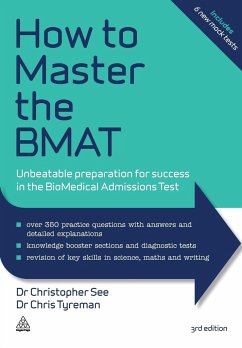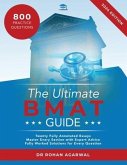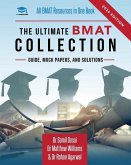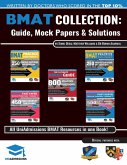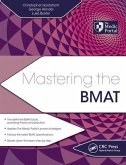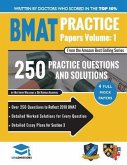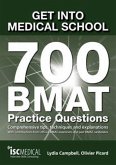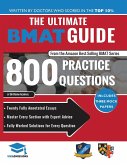Dr. Christopher See, Chris John Tyreman
How to Master the Bmat
Unbeatable Preparation for Success in the Biomedical Admissions Test
Dr. Christopher See, Chris John Tyreman
How to Master the Bmat
Unbeatable Preparation for Success in the Biomedical Admissions Test
- Broschiertes Buch
- Merkliste
- Auf die Merkliste
- Bewerten Bewerten
- Teilen
- Produkt teilen
- Produkterinnerung
- Produkterinnerung
Prepare for your BMAT with this quick and easy guide featuring over 420 practice questions, including mock tests, revision topics and video podcasts.
Andere Kunden interessierten sich auch für
![The Ultimate BMAT Guide: Fully Worked Solutions to over 800 BMAT practice questions, alongside Time Saving Techniques, Score Boosting Strategie The Ultimate BMAT Guide: Fully Worked Solutions to over 800 BMAT practice questions, alongside Time Saving Techniques, Score Boosting Strategie]() Rohan AgarwalThe Ultimate BMAT Guide: Fully Worked Solutions to over 800 BMAT practice questions, alongside Time Saving Techniques, Score Boosting Strategie25,99 €
Rohan AgarwalThe Ultimate BMAT Guide: Fully Worked Solutions to over 800 BMAT practice questions, alongside Time Saving Techniques, Score Boosting Strategie25,99 €![The Ultimate BMAT Collection The Ultimate BMAT Collection]() Dr Rohan AgarwalThe Ultimate BMAT Collection44,99 €
Dr Rohan AgarwalThe Ultimate BMAT Collection44,99 €![The Ultimate BMAT Collection: 5 Books In One, Over 2500 Practice Questions & Solutions, Includes 8 Mock Papers, Detailed Essay Plans, BioMedical Adm The Ultimate BMAT Collection: 5 Books In One, Over 2500 Practice Questions & Solutions, Includes 8 Mock Papers, Detailed Essay Plans, BioMedical Adm]() Matthew WilliamsThe Ultimate BMAT Collection: 5 Books In One, Over 2500 Practice Questions & Solutions, Includes 8 Mock Papers, Detailed Essay Plans, BioMedical Adm56,99 €
Matthew WilliamsThe Ultimate BMAT Collection: 5 Books In One, Over 2500 Practice Questions & Solutions, Includes 8 Mock Papers, Detailed Essay Plans, BioMedical Adm56,99 €![Mastering the BMAT Mastering the BMAT]() Christopher NordstromMastering the BMAT34,99 €
Christopher NordstromMastering the BMAT34,99 €![BMAT Practice Papers Volume 1 BMAT Practice Papers Volume 1]() Rohan AgarwalBMAT Practice Papers Volume 155,99 €
Rohan AgarwalBMAT Practice Papers Volume 155,99 €![Get into Medical School - 700 BMAT Practice Questions Get into Medical School - 700 BMAT Practice Questions]() Lydia CampbellGet into Medical School - 700 BMAT Practice Questions22,99 €
Lydia CampbellGet into Medical School - 700 BMAT Practice Questions22,99 €![The Ultimate BMAT Guide: 800 Practice Questions The Ultimate BMAT Guide: 800 Practice Questions]() Rohan AgarwalThe Ultimate BMAT Guide: 800 Practice Questions34,99 €
Rohan AgarwalThe Ultimate BMAT Guide: 800 Practice Questions34,99 €-
-
-
Prepare for your BMAT with this quick and easy guide featuring over 420 practice questions, including mock tests, revision topics and video podcasts.
Hinweis: Dieser Artikel kann nur an eine deutsche Lieferadresse ausgeliefert werden.
Hinweis: Dieser Artikel kann nur an eine deutsche Lieferadresse ausgeliefert werden.
Produktdetails
- Produktdetails
- Verlag: Kogan Page Ltd
- 3 Revised edition
- Seitenzahl: 304
- Erscheinungstermin: 1. April 2015
- Englisch
- Abmessung: 244mm x 170mm x 17mm
- Gewicht: 534g
- ISBN-13: 9780749471873
- ISBN-10: 0749471875
- Artikelnr.: 41611125
- Herstellerkennzeichnung
- Books on Demand GmbH
- In de Tarpen 42
- 22848 Norderstedt
- info@bod.de
- 040 53433511
- Verlag: Kogan Page Ltd
- 3 Revised edition
- Seitenzahl: 304
- Erscheinungstermin: 1. April 2015
- Englisch
- Abmessung: 244mm x 170mm x 17mm
- Gewicht: 534g
- ISBN-13: 9780749471873
- ISBN-10: 0749471875
- Artikelnr.: 41611125
- Herstellerkennzeichnung
- Books on Demand GmbH
- In de Tarpen 42
- 22848 Norderstedt
- info@bod.de
- 040 53433511
Dr. Christopher See is the author of Succeed in Your Medical School Interview, How to Get Into Oxbridge, and How to Get Into Medical School (all published by Kogan Page). Chris Tyreman is the bestselling testing author of How to Master Nursing Calculations, How to Pass the QTS Numeracy Tests and co-author of How to Master the UKCAT (Kogan Page).
Introduction
PART ONE
Reviews
1. Aptitude and skills review
A1. Understanding argument 1: basic aspects
A2. Understanding argument 2: flaws; types of questions
A3. Understanding argument 3: example argument
A4. Critical thinking: Venn diagrams and logic statements
A5. Shape symmetry
Aptitude review questions
2. Maths review
M1. Mental arithmetic review 1: basic operations
M2. Mental arithmetic review 2: further operations
M3. Fractions 1: basic arithmetic
M4. Fractions 2: improper fractions; ratios
M5. Decimals 1: fraction/decimal conversions and basic arithmetic
M6. Decimals 2: rounding (decimal place, significant figure) and standard
form
M7. Per cent (%)
M8. Time and clocks
M9. Areas, perimeters, volumes and surface area
M10. Algebra 1: substitution and re-arranging
M11. Algebra 2: simultaneous and quadratic equations
M12. Averages: mean, median, mode; weighted
M13. Pie and bar charts, line and scatter graphs, tables
M14. Cumulative frequency, box and whisker plots
M15. Geometry 1: angles and lines, triangles, other shapes
M16. Geometry 2: Pythagoras and trigonometric functions
M17. Circle theorems
M18. Inequalities
M19. Probability 1: basic concepts
M20. Probability 2: tree diagrams
M21. Permutations and combinations
Maths review questions
3. Physics review
P1. Measurements and prefixes
P2. Conventions for units, symbols and numbers
P3. SI base units for length, volume, mass
P4. Equations of motion
P5. Graphs of motion
P6. Projectile motion
P7. Force and motion (Newton)
P8. Force, work, power and energy
P9. Universal gravitation, satellites and escape velocity
P10. Force, momentum and impulse
P11. Force, stress and strain
P12. Moments, mechanical advantage, levers and pulleys
P13. Pressure, buoyancy and flow
P14. Gas laws
P15. Heat and energy
P16. Waves (light and sound)
P17. Electrostatics, capacitance and electricity
P18. Kirchhoff's circuit laws, resistors and capacitors
P19. Electromagnetism and electromagnetic induction
P20. Radioactive decay
Physics review questions
4. Chemistry review
C1. Atoms, electron configuration and valency
C2. Periodic table
C3. Bonding: electrovalent (ionic), covalent and metallic
C4. The mole and balancing chemical equations (reactions)
C5. Types of chemical reaction
C6. Concentration and pH; reaction rates
C7. Exothermic and endodermic reactions; Le Chatelier's principle
C8. Solids, liquids, gases; changes of state; thermochemistry
C9. Electrochemistry, reactivity series and electrolysis
C10. Carbon (organic) chemistry; fractional distillation
Chemistry review questions
5. Biology review
B1. Digestive system
B2. Respiratory system
B3. Circulatory system
B4. Nervous system
B5. Endocrine system; menstrual cycle hormones
B6. Urinary system
B7. DNA (deoxyribonucleic acid), genes and cell division
B8. Patterns of inheritance
Biology review questions
6. Writing task review
W1. Choice of question
W2. Preparation
W3. The four-paragraph approach
W4. Composing the essay
W5. Sources and resources
W6. The final check
Instructions for mock tests
PART TWO
Tests and answers
7. Mock tests
Mock Test 1: Aptitude and skills
Mock Test 2: Scientific knowledge and applications
Mock Test 3: Writing task
Mock Test 4: Aptitude and skills
Mock Test 5: Scientific knowledge and applications
Mock Test 6: Writing task
Mock Test 7: Aptitude and skills
Mock Test 8: Scientific knowledge and applications
Mock Test 9: Writing task
Mock Test 10: Aptitude and skills
Mock Test 11: Scientific knowledge and skills
Mock Test 12: Writing task
Mock Test 13: Aptitude and skills
Mock Test 14: Scientific knowledge and applications
Mock Test 15: Writing task
8. Answers and explanations
Answers to review questions
Answers to mock tests
PART ONE
Reviews
1. Aptitude and skills review
A1. Understanding argument 1: basic aspects
A2. Understanding argument 2: flaws; types of questions
A3. Understanding argument 3: example argument
A4. Critical thinking: Venn diagrams and logic statements
A5. Shape symmetry
Aptitude review questions
2. Maths review
M1. Mental arithmetic review 1: basic operations
M2. Mental arithmetic review 2: further operations
M3. Fractions 1: basic arithmetic
M4. Fractions 2: improper fractions; ratios
M5. Decimals 1: fraction/decimal conversions and basic arithmetic
M6. Decimals 2: rounding (decimal place, significant figure) and standard
form
M7. Per cent (%)
M8. Time and clocks
M9. Areas, perimeters, volumes and surface area
M10. Algebra 1: substitution and re-arranging
M11. Algebra 2: simultaneous and quadratic equations
M12. Averages: mean, median, mode; weighted
M13. Pie and bar charts, line and scatter graphs, tables
M14. Cumulative frequency, box and whisker plots
M15. Geometry 1: angles and lines, triangles, other shapes
M16. Geometry 2: Pythagoras and trigonometric functions
M17. Circle theorems
M18. Inequalities
M19. Probability 1: basic concepts
M20. Probability 2: tree diagrams
M21. Permutations and combinations
Maths review questions
3. Physics review
P1. Measurements and prefixes
P2. Conventions for units, symbols and numbers
P3. SI base units for length, volume, mass
P4. Equations of motion
P5. Graphs of motion
P6. Projectile motion
P7. Force and motion (Newton)
P8. Force, work, power and energy
P9. Universal gravitation, satellites and escape velocity
P10. Force, momentum and impulse
P11. Force, stress and strain
P12. Moments, mechanical advantage, levers and pulleys
P13. Pressure, buoyancy and flow
P14. Gas laws
P15. Heat and energy
P16. Waves (light and sound)
P17. Electrostatics, capacitance and electricity
P18. Kirchhoff's circuit laws, resistors and capacitors
P19. Electromagnetism and electromagnetic induction
P20. Radioactive decay
Physics review questions
4. Chemistry review
C1. Atoms, electron configuration and valency
C2. Periodic table
C3. Bonding: electrovalent (ionic), covalent and metallic
C4. The mole and balancing chemical equations (reactions)
C5. Types of chemical reaction
C6. Concentration and pH; reaction rates
C7. Exothermic and endodermic reactions; Le Chatelier's principle
C8. Solids, liquids, gases; changes of state; thermochemistry
C9. Electrochemistry, reactivity series and electrolysis
C10. Carbon (organic) chemistry; fractional distillation
Chemistry review questions
5. Biology review
B1. Digestive system
B2. Respiratory system
B3. Circulatory system
B4. Nervous system
B5. Endocrine system; menstrual cycle hormones
B6. Urinary system
B7. DNA (deoxyribonucleic acid), genes and cell division
B8. Patterns of inheritance
Biology review questions
6. Writing task review
W1. Choice of question
W2. Preparation
W3. The four-paragraph approach
W4. Composing the essay
W5. Sources and resources
W6. The final check
Instructions for mock tests
PART TWO
Tests and answers
7. Mock tests
Mock Test 1: Aptitude and skills
Mock Test 2: Scientific knowledge and applications
Mock Test 3: Writing task
Mock Test 4: Aptitude and skills
Mock Test 5: Scientific knowledge and applications
Mock Test 6: Writing task
Mock Test 7: Aptitude and skills
Mock Test 8: Scientific knowledge and applications
Mock Test 9: Writing task
Mock Test 10: Aptitude and skills
Mock Test 11: Scientific knowledge and skills
Mock Test 12: Writing task
Mock Test 13: Aptitude and skills
Mock Test 14: Scientific knowledge and applications
Mock Test 15: Writing task
8. Answers and explanations
Answers to review questions
Answers to mock tests
Introduction
PART ONE
Reviews
1. Aptitude and skills review
A1. Understanding argument 1: basic aspects
A2. Understanding argument 2: flaws; types of questions
A3. Understanding argument 3: example argument
A4. Critical thinking: Venn diagrams and logic statements
A5. Shape symmetry
Aptitude review questions
2. Maths review
M1. Mental arithmetic review 1: basic operations
M2. Mental arithmetic review 2: further operations
M3. Fractions 1: basic arithmetic
M4. Fractions 2: improper fractions; ratios
M5. Decimals 1: fraction/decimal conversions and basic arithmetic
M6. Decimals 2: rounding (decimal place, significant figure) and standard
form
M7. Per cent (%)
M8. Time and clocks
M9. Areas, perimeters, volumes and surface area
M10. Algebra 1: substitution and re-arranging
M11. Algebra 2: simultaneous and quadratic equations
M12. Averages: mean, median, mode; weighted
M13. Pie and bar charts, line and scatter graphs, tables
M14. Cumulative frequency, box and whisker plots
M15. Geometry 1: angles and lines, triangles, other shapes
M16. Geometry 2: Pythagoras and trigonometric functions
M17. Circle theorems
M18. Inequalities
M19. Probability 1: basic concepts
M20. Probability 2: tree diagrams
M21. Permutations and combinations
Maths review questions
3. Physics review
P1. Measurements and prefixes
P2. Conventions for units, symbols and numbers
P3. SI base units for length, volume, mass
P4. Equations of motion
P5. Graphs of motion
P6. Projectile motion
P7. Force and motion (Newton)
P8. Force, work, power and energy
P9. Universal gravitation, satellites and escape velocity
P10. Force, momentum and impulse
P11. Force, stress and strain
P12. Moments, mechanical advantage, levers and pulleys
P13. Pressure, buoyancy and flow
P14. Gas laws
P15. Heat and energy
P16. Waves (light and sound)
P17. Electrostatics, capacitance and electricity
P18. Kirchhoff's circuit laws, resistors and capacitors
P19. Electromagnetism and electromagnetic induction
P20. Radioactive decay
Physics review questions
4. Chemistry review
C1. Atoms, electron configuration and valency
C2. Periodic table
C3. Bonding: electrovalent (ionic), covalent and metallic
C4. The mole and balancing chemical equations (reactions)
C5. Types of chemical reaction
C6. Concentration and pH; reaction rates
C7. Exothermic and endodermic reactions; Le Chatelier's principle
C8. Solids, liquids, gases; changes of state; thermochemistry
C9. Electrochemistry, reactivity series and electrolysis
C10. Carbon (organic) chemistry; fractional distillation
Chemistry review questions
5. Biology review
B1. Digestive system
B2. Respiratory system
B3. Circulatory system
B4. Nervous system
B5. Endocrine system; menstrual cycle hormones
B6. Urinary system
B7. DNA (deoxyribonucleic acid), genes and cell division
B8. Patterns of inheritance
Biology review questions
6. Writing task review
W1. Choice of question
W2. Preparation
W3. The four-paragraph approach
W4. Composing the essay
W5. Sources and resources
W6. The final check
Instructions for mock tests
PART TWO
Tests and answers
7. Mock tests
Mock Test 1: Aptitude and skills
Mock Test 2: Scientific knowledge and applications
Mock Test 3: Writing task
Mock Test 4: Aptitude and skills
Mock Test 5: Scientific knowledge and applications
Mock Test 6: Writing task
Mock Test 7: Aptitude and skills
Mock Test 8: Scientific knowledge and applications
Mock Test 9: Writing task
Mock Test 10: Aptitude and skills
Mock Test 11: Scientific knowledge and skills
Mock Test 12: Writing task
Mock Test 13: Aptitude and skills
Mock Test 14: Scientific knowledge and applications
Mock Test 15: Writing task
8. Answers and explanations
Answers to review questions
Answers to mock tests
PART ONE
Reviews
1. Aptitude and skills review
A1. Understanding argument 1: basic aspects
A2. Understanding argument 2: flaws; types of questions
A3. Understanding argument 3: example argument
A4. Critical thinking: Venn diagrams and logic statements
A5. Shape symmetry
Aptitude review questions
2. Maths review
M1. Mental arithmetic review 1: basic operations
M2. Mental arithmetic review 2: further operations
M3. Fractions 1: basic arithmetic
M4. Fractions 2: improper fractions; ratios
M5. Decimals 1: fraction/decimal conversions and basic arithmetic
M6. Decimals 2: rounding (decimal place, significant figure) and standard
form
M7. Per cent (%)
M8. Time and clocks
M9. Areas, perimeters, volumes and surface area
M10. Algebra 1: substitution and re-arranging
M11. Algebra 2: simultaneous and quadratic equations
M12. Averages: mean, median, mode; weighted
M13. Pie and bar charts, line and scatter graphs, tables
M14. Cumulative frequency, box and whisker plots
M15. Geometry 1: angles and lines, triangles, other shapes
M16. Geometry 2: Pythagoras and trigonometric functions
M17. Circle theorems
M18. Inequalities
M19. Probability 1: basic concepts
M20. Probability 2: tree diagrams
M21. Permutations and combinations
Maths review questions
3. Physics review
P1. Measurements and prefixes
P2. Conventions for units, symbols and numbers
P3. SI base units for length, volume, mass
P4. Equations of motion
P5. Graphs of motion
P6. Projectile motion
P7. Force and motion (Newton)
P8. Force, work, power and energy
P9. Universal gravitation, satellites and escape velocity
P10. Force, momentum and impulse
P11. Force, stress and strain
P12. Moments, mechanical advantage, levers and pulleys
P13. Pressure, buoyancy and flow
P14. Gas laws
P15. Heat and energy
P16. Waves (light and sound)
P17. Electrostatics, capacitance and electricity
P18. Kirchhoff's circuit laws, resistors and capacitors
P19. Electromagnetism and electromagnetic induction
P20. Radioactive decay
Physics review questions
4. Chemistry review
C1. Atoms, electron configuration and valency
C2. Periodic table
C3. Bonding: electrovalent (ionic), covalent and metallic
C4. The mole and balancing chemical equations (reactions)
C5. Types of chemical reaction
C6. Concentration and pH; reaction rates
C7. Exothermic and endodermic reactions; Le Chatelier's principle
C8. Solids, liquids, gases; changes of state; thermochemistry
C9. Electrochemistry, reactivity series and electrolysis
C10. Carbon (organic) chemistry; fractional distillation
Chemistry review questions
5. Biology review
B1. Digestive system
B2. Respiratory system
B3. Circulatory system
B4. Nervous system
B5. Endocrine system; menstrual cycle hormones
B6. Urinary system
B7. DNA (deoxyribonucleic acid), genes and cell division
B8. Patterns of inheritance
Biology review questions
6. Writing task review
W1. Choice of question
W2. Preparation
W3. The four-paragraph approach
W4. Composing the essay
W5. Sources and resources
W6. The final check
Instructions for mock tests
PART TWO
Tests and answers
7. Mock tests
Mock Test 1: Aptitude and skills
Mock Test 2: Scientific knowledge and applications
Mock Test 3: Writing task
Mock Test 4: Aptitude and skills
Mock Test 5: Scientific knowledge and applications
Mock Test 6: Writing task
Mock Test 7: Aptitude and skills
Mock Test 8: Scientific knowledge and applications
Mock Test 9: Writing task
Mock Test 10: Aptitude and skills
Mock Test 11: Scientific knowledge and skills
Mock Test 12: Writing task
Mock Test 13: Aptitude and skills
Mock Test 14: Scientific knowledge and applications
Mock Test 15: Writing task
8. Answers and explanations
Answers to review questions
Answers to mock tests

